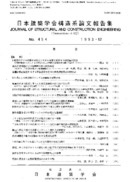391 巻
選択された号の論文の15件中1~15を表示しています
- |<
- <
- 1
- >
- >|
-
原稿種別: 表紙
1988 年 391 巻 p. Cover1-
発行日: 1988/09/30
公開日: 2017/12/25
PDF形式でダウンロード (45K) -
原稿種別: 表紙
1988 年 391 巻 p. Cover2-
発行日: 1988/09/30
公開日: 2017/12/25
PDF形式でダウンロード (45K) -
原稿種別: 目次
1988 年 391 巻 p. Toc1-
発行日: 1988/09/30
公開日: 2017/12/25
PDF形式でダウンロード (44K) -
原稿種別: 付録等
1988 年 391 巻 p. App1-
発行日: 1988/09/30
公開日: 2017/12/25
PDF形式でダウンロード (51K) -
原稿種別: 付録等
1988 年 391 巻 p. App2-
発行日: 1988/09/30
公開日: 2017/12/25
PDF形式でダウンロード (51K) -
原稿種別: 本文
1988 年 391 巻 p. 1-9
発行日: 1988/09/30
公開日: 2017/12/25
PDF形式でダウンロード (943K) -
原稿種別: 本文
1988 年 391 巻 p. 10-18
発行日: 1988/09/30
公開日: 2017/12/25
PDF形式でダウンロード (907K) -
原稿種別: 本文
1988 年 391 巻 p. 19-26
発行日: 1988/09/30
公開日: 2017/12/25
PDF形式でダウンロード (1049K) -
原稿種別: 本文
1988 年 391 巻 p. 27-35
発行日: 1988/09/30
公開日: 2017/12/25
PDF形式でダウンロード (896K) -
原稿種別: 本文
1988 年 391 巻 p. 36-44
発行日: 1988/09/30
公開日: 2017/12/25
PDF形式でダウンロード (1140K) -
原稿種別: 本文
1988 年 391 巻 p. 45-58
発行日: 1988/09/30
公開日: 2017/12/25
PDF形式でダウンロード (1539K) -
原稿種別: 本文
1988 年 391 巻 p. 59-71
発行日: 1988/09/30
公開日: 2017/12/25
PDF形式でダウンロード (1205K) -
原稿種別: 本文
1988 年 391 巻 p. 72-80
発行日: 1988/09/30
公開日: 2017/12/25
PDF形式でダウンロード (1155K) -
原稿種別: 付録等
1988 年 391 巻 p. App3-
発行日: 1988/09/30
公開日: 2017/12/25
PDF形式でダウンロード (64K) -
原稿種別: 表紙
1988 年 391 巻 p. Cover3-
発行日: 1988/09/30
公開日: 2017/12/25
PDF形式でダウンロード (5K)
- |<
- <
- 1
- >
- >|
